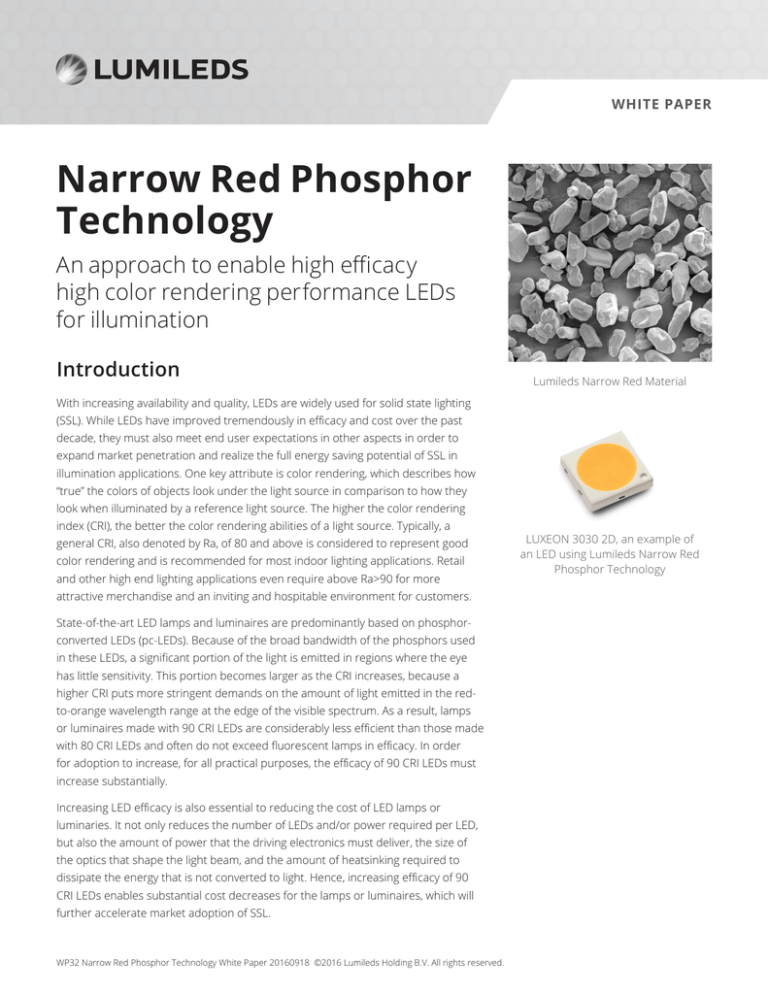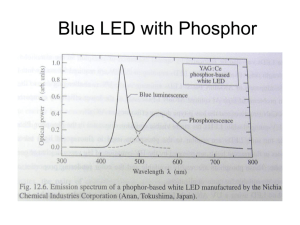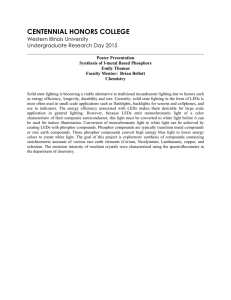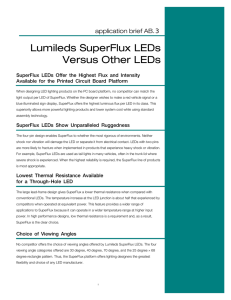
White Paper
Narrow Red Phosphor
Technology
An approach to enable high efficacy
high color rendering performance LEDs
for illumination
Introduction
Lumileds Narrow Red Material
With increasing availability and quality, LEDs are widely used for solid state lighting
(SSL). While LEDs have improved tremendously in efficacy and cost over the past
decade, they must also meet end user expectations in other aspects in order to
expand market penetration and realize the full energy saving potential of SSL in
illumination applications. One key attribute is color rendering, which describes how
“true” the colors of objects look under the light source in comparison to how they
look when illuminated by a reference light source. The higher the color rendering
index (CRI), the better the color rendering abilities of a light source. Typically, a
general CRI, also denoted by Ra, of 80 and above is considered to represent good
color rendering and is recommended for most indoor lighting applications. Retail
and other high end lighting applications even require above Ra>90 for more
attractive merchandise and an inviting and hospitable environment for customers.
State-of-the-art LED lamps and luminaires are predominantly based on phosphorconverted LEDs (pc-LEDs). Because of the broad bandwidth of the phosphors used
in these LEDs, a significant portion of the light is emitted in regions where the eye
has little sensitivity. This portion becomes larger as the CRI increases, because a
higher CRI puts more stringent demands on the amount of light emitted in the redto-orange wavelength range at the edge of the visible spectrum. As a result, lamps
or luminaires made with 90 CRI LEDs are considerably less efficient than those made
with 80 CRI LEDs and often do not exceed fluorescent lamps in efficacy. In order
for adoption to increase, for all practical purposes, the efficacy of 90 CRI LEDs must
increase substantially.
Increasing LED efficacy is also essential to reducing the cost of LED lamps or
luminaries. It not only reduces the number of LEDs and/or power required per LED,
but also the amount of power that the driving electronics must deliver, the size of
the optics that shape the light beam, and the amount of heatsinking required to
dissipate the energy that is not converted to light. Hence, increasing efficacy of 90
CRI LEDs enables substantial cost decreases for the lamps or luminaires, which will
further accelerate market adoption of SSL.
WP32 Narrow Red Phosphor Technology White Paper 20160918 ©2016 Lumileds Holding B.V. All rights reserved.
LUXEON 3030 2D, an example of
an LED using Lumileds Narrow Red
Phosphor Technology
Technical approach
Aside from the pc-LED architecture, white light can also be generated from color-mixed LEDs, i.e. a combination of red, green,
blue and amber direct-emitting LEDs, or hybrid LEDs, which combine phosphor-converted and direct-emitting LEDs.
Color-mixed LEDs are theoretically the most efficient architecture, as their narrow emission spectrum allows for a high luminous
efficacy of radiation (LER) and they do not suffer from the energy loss associated with phosphor down-conversion (referred to as
Stokes loss). In practice, however, the efficacy of direct-emitting green and amber LEDs are far below that of blue and red LEDs,
leading to a white LED efficacy that is significantly lower than pc-LEDs.
Hybrid LEDs can generate high-CRI light with high efficacy by combining phosphor-converted off-white LEDs and direct-emitting
red LEDs. The narrow optical bandwidth of the red LEDs ensures a high CRI without significant emission in the deep red and
infrared. This approach is used in the Philips L Prize lamp [1], for example, and is the most efficient 90CRI architecture with
technology available today. However, it is difficult to maintain a constant light color over time as the red and off-white LEDs
degrade at different rates and have different temperature and current dependencies. The driver electronics must be substantially
more complex than those for pc-LEDs in order to balance the light from the two LED sources and keep light color constant over
temperature and time. Due to the cost associated with this complexity, this approach is not widely adopted. Table 1 illustrates the
difference between color-mixed, hybrid and p-c LED systems.
Table 1. Comparisons between different LED systems.
Color-mixed LEDs
Hybrid LEDs
Phosphor-converted LEDs
CRI
-
+
++
Efficacy
--
++
+
$$$
$$$
$
System cost
Phosphor-converted LEDs can simultaneously achieve the efficacy and cost targets, provided the emission spectrum of the red
phosphor is significantly narrowed. Figure 1 illustrates the development targets for narrow-band phosphors based on a spectral
model of a pc-LED with two phosphors (red and green). We optimize the conversion efficacy (CE) of the phosphor by varying the
bandwidths and peak positions of the phosphor emission spectra. CE quantifies how many lumens an LED produces for one
watt of blue light emitted by the pump LED. The maximum CE is calculated based on the luminous efficacy of radiation contained
in the spectrum and the Stokes loss. As shown in Figure 1, the most significant improvements are realized by reducing the
bandwidth of the red phosphor.
Figure 1. Maximum CE of model pc-LED at 3000K, CRI Ra≥90 and R9>50.
A modest additional efficacy increase may be realized by narrowing the green phosphor as well, but the improvement is smaller
because the green is more centered in the visible wavelength range. For a CCT of 3000K and a CRI with Ra≥90 and R9>50, a
spectrum with broadband red and green phosphors both having 110nm full width at half maximum yields a maximum CE of
239 lm/W. By reducing the red phosphor bandwidth to 30 nm, the CE can be increased to 291lm/W—an improvement of 22%.
Figure 2 shows the corresponding modeled spectrum, illustrating that the wasted emission in the deep red and infrared (beyond
650nm) is strongly reduced in comparison to state-of-the-art 90CRI LEDs with broadband red phosphors.
WP32 Narrow Red Phosphor Technology White Paper 20160918 ©2016 Lumileds Holding B.V. All rights reserved.
2
Figure 2. Typical spectrum of a state-of-the-art 90CRI LED, showing tail of emission into deep red and infrared,
and modeled spectrum of a 90CRI pc-LED with narrow-band red phosphor.
To obtain the total efficacy of the pc-LED, these CE values must be multiplied by the power conversion efficiency of the blue pump
LED, the quantum efficiency of the phosphor down-conversion, and the package efficiency.
LED development
The analysis demonstrates that development and implementation of narrow-band red phosphors in LEDs is a key enabler for
efficacy and cost improvements. Narrow-band red materials are emerging and have recently been introduced in display products
for increased color gamut, but have not yet been successfully commercialized in illumination products due to their low efficiency
at relevant temperatures and flux density. Recent work by Lumileds has revealed narrow-band red materials with superior
luminescence properties at realistic operating conditions [2]. Lumileds has been able to bring products based on these materials
to mass production in 2015.
Based on the market’s wide adoption of mid power LEDs in recent years, Lumileds has chosen to first employ its narrow-band
red material technology in their mid power LED family. Among LED package types, mid power LEDs provide the best architecture
for low-cost, high-efficacy, omnidirectional illumination applications. Based on a lateral die encased in a low-cost package with a
phosphor silicone suspension, mid power LEDs offer low cost due to their architectural simplicity, high performance due to the
high package efficiency, and design flexibility due to their small flux increments. An example of a leading mid power product from
Lumileds developed using the narrow red technology is the LUXEON 3535L HE (Figure 3). Figure 4 shows existing performance
and projected end of year performance for this product.
Figure 3. LUXEON 3535L HE.
WP32 Narrow Red Phosphor Technology White Paper 20160918 ©2016 Lumileds Holding B.V. All rights reserved.
3
Figure 4. LUXEON 3535L HE with narrow-band red phosphor at 3000K, 25ºC, CRI Ra≥90 and R9>50.
Recent advances in materials technology and manufacturing techniques provide significant opportunities to increase the efficacy
and the stability of mid power devices. Besides lumen maintenance, color stability is a concern for many applications. Current
mid power devices typically meet the ENERGY STAR requirement that Δu’v’<0.007 after 6,000 hours, but they continue to degrade
over time, limiting their useful lifetime in color-critical applications. In addition to package material deterioration, color shift in mid
power LEDs can arise from degradation of the red phosphor, aggravated by the increased thermal load in these devices. LUXEON
3535L HE LEDs that incorporate the narrow red phosphor can enable higher drive conditions with cheaper heat sinks, while
enabling improved reliability. Ongoing LM80 testing showed that the package has good lumen and color maintenance after 3000
hours of stress, compared to traditional 90CRI red phosphor in the same package type (Figure 5).
LUXEON LEDs that utilize the narrow red phosphor technology have been commercially released, with very positive feedback.
Given the market’s vote of confidence, the next step is to proliferate the narrow red phosphor technology to other LED platforms
within the mid power or high power space. These cost-effective LEDs deliver high quality light and will further expedite the LED
penetration rate for illumination applications.
Figure 5. 3000+ hours LM-80 results for LUXEON 3535L HE with narrow-band red phosphor vs. with traditional red phosphor.
References
1. Kluger, Jeffrey. “The 50 Best Inventions of 2009.” TIME 12 Nov. 2009: n. pag. Print.
2. P. Pust, V. Weiler, C. Hecht, A. Tucks, A. S. Wochnik, A-K Henss, D. Wiechert, C. Scheu, P. J. Schmidt, and W. Schnick, “Narrow-band red-emitting S[LiAl3N4]:Eu2+ as a
next-generation LED-phosphor material,” Nature Materials 13 (2014), 891–896
WP32 Narrow Red Phosphor Technology White Paper 20160918 ©2016 Lumileds Holding B.V. All rights reserved.
4
About Lumileds
Lumileds is the global leader in light engine technology. The company develops, manufactures and distributes groundbreaking
LEDs and automotive lighting products that shatter the status quo and help customers gain and maintain a competitive edge.
With a rich history of industry “firsts,” Lumileds is uniquely positioned to deliver lighting advancements well into the future by
maintaining an unwavering focus on quality, innovation and reliability.
To learn more about our portfolio of light engines, visit lumileds.com.
©2016 Lumileds Holding B.V. All rights reserved.
LUXEON is a registered trademark of the Lumileds Holding B.V.
in the United States and other countries.
lumileds.com
WP32 Narrow Red Phosphor Technology
White Paper 20160918
Neither Lumileds Holding B.V. nor its affiliates shall be liable for any kind of loss of data or any
other damages, direct, indirect or consequential, resulting from the use of the provided
information and data. Although Lumileds Holding B.V. and/or its affiliates have attempted to
provide the most accurate information and data, the materials and services information and data
are provided “as is,” and neither Lumileds Holding B.V. nor its affiliates warrants or guarantees
the contents and correctness of the provided information and data. Lumileds Holding B.V. and its
affiliates reserve the right to make changes without notice. You as user agree to this disclaimer
and user agreement with the download or use of the provided materials, information and data.






